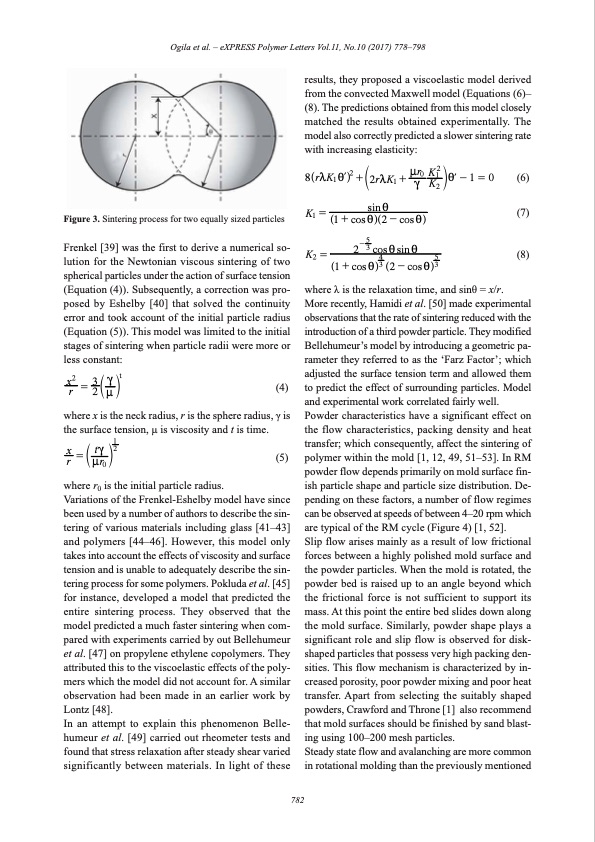
PDF Publication Title:
Text from PDF Page: 006
Ogila et al. – eXPRESS Polymer Letters Vol.11, No.10 (2017) 778–798 results, they proposed a viscoelastic model derived from the convected Maxwell model (Equations (6)– (8). The predictions obtained from this model closely matched the results obtained experimentally. The model also correctly predicted a slower sintering rate with increasing elasticity: nr0 K2 1 Zil-1=0 (6) Q1+cosiV43 Q2-cosiV53 where λ is the relaxation time, and sinθ = x/r. More recently, Hamidi et al. [50] made experimental observations that the rate of sintering reduced with the introduction of a third powder particle. They modified Bellehumeur’s model by introducing a geometric pa- rameter they referred to as the ‘Farz Factor’; which adjusted the surface tension term and allowed them to predict the effect of surrounding particles. Model and experimental work correlated fairly well. Powder characteristics have a significant effect on the flow characteristics, packing density and heat transfer; which consequently, affect the sintering of polymer within the mold [1, 12, 49, 51–53]. In RM powder flow depends primarily on mold surface fin- ish particle shape and particle size distribution. De- pending on these factors, a number of flow regimes can be observed at speeds of between 4–20 rpm which are typical of the RM cycle (Figure 4) [1, 52]. Slip flow arises mainly as a result of low frictional forces between a highly polished mold surface and the powder particles. When the mold is rotated, the powder bed is raised up to an angle beyond which the frictional force is not sufficient to support its mass. At this point the entire bed slides down along the mold surface. Similarly, powder shape plays a significant role and slip flow is observed for disk- shaped particles that possess very high packing den- sities. This flow mechanism is characterized by in- creased porosity, poor powder mixing and poor heat transfer. Apart from selecting the suitably shaped powders, Crawford and Throne [1] also recommend that mold surfaces should be finished by sand blast- ing using 100–200 mesh particles. Steady state flow and avalanching are more common in rotational molding than the previously mentioned 2 8QrmK1ilV +U2rmK + 1 K1 = K = c K2 sini Q1+cosiVQ2-cosiV Figure 3. Sintering process for two equally sized particles Frenkel [39] was the first to derive a numerical so- lution for the Newtonian viscous sintering of two spherical particles under the action of surface tension (Equation (4)). Subsequently, a correction was pro- posed by Eshelby [40] that solved the continuity error and took account of the initial particle radius (Equation (5)). This model was limited to the initial stages of sintering when particle radii were more or less constant: the surface tension, μ is viscosity and t is time. 1 x = T tc Y2 r nr where r0 is the initial particle radius. Variations of the Frenkel-Eshelby model have since been used by a number of authors to describe the sin- tering of various materials including glass [41–43] and polymers [44–46]. However, this model only takes into account the effects of viscosity and surface tension and is unable to adequately describe the sin- tering process for some polymers. Pokluda et al. [45] for instance, developed a model that predicted the entire sintering process. They observed that the model predicted a much faster sintering when com- pared with experiments carried by out Bellehumeur et al. [47] on propylene ethylene copolymers. They attributed this to the viscoelastic effects of the poly- mers which the model did not account for. A similar observation had been made in an earlier work by Lontz [48]. In an attempt to explain this phenomenon Belle- humeur et al. [49] carried out rheometer tests and found that stress relaxation after steady shear varied significantly between materials. In light of these 2 (7) 2-53cosisini (8) x2 3ct r =2TnY (4) where x is the neck radius, r is the sphere radius, γ is 0 (5) 782PDF Image | Rotational molding: A review

PDF Search Title:
Rotational molding: A reviewOriginal File Name Searched:
Rotational_molding_A_review_of_the_models_and_mate.pdfDIY PDF Search: Google It | Yahoo | Bing
Development of a solar powered Electric Ship The Electricship website originally started off as a project to develop a comprehensive renewable, affordable, modular electric ship... More Info
Modular Boat Hull Composite The case for a unsinkable, modular composite hybrid boat hull... More Info
MS Burgenstock Hybrid Electric Catamaran Lake Lucerne Unique shuttle servicing Lucerne to the Burgenstock Resort... More Info
Ground Power Unit GPU Powered by Lithium Ion Batteries The goal of the Ground Power Unit is to provide a readily accessible, modular, ready-to-power solution for remote power... More Info
| CONTACT TEL: 608-238-6001 Email: greg@electricship.com | RSS | AMP |